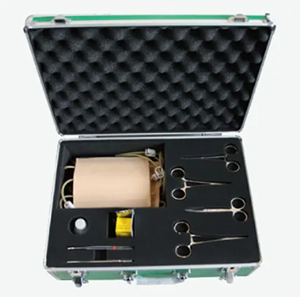Homepageпјҡ NEWS >> Can the surface vessel ligation hemostasis model simulate the ability of rapid hemostasis in emergency situations?
Blood vessel ligation and hemostasis is a key technique in treating massive bleeding in medical emergency and surgical operations. Especially in emergency situations, rapid and effective hemostatic ability is directly related to the life safety of patients. Therefore, it is essential to train medical personnel to quickly and accurately perform vascular ligation to stop bleeding in high-pressure environments. As a simulation tool, surface vessel ligation hemostasis model has become an important topic in medical education whether it can effectively simulate the ability of rapid hemostasis in emergency situations.
The ability to simulate emergency situations
The design of surface vessel ligation hemostasis model is usually based on the simulation of various common vascular structures, which can reproduce the vascular and soft tissue responses in different sites. Modern training models can not only simulate the physical characteristics of blood vessels such as tension and hardness, but also provide real-time data of student operations through intelligent feedback systems to help students respond quickly in emergency situations. However, although these models are highly simulated in training, they are still unable to fully replicate the psychological stress and environmental factors in real clinical situations.

Surface vessel ligation hemostasis model
Industry expert view
Many industry experts consider surface vessel ligation hemostasis models to be an indispensable tool in first-aid skills training. Through simulated emergency situations, participants can practice ligature techniques repeatedly in a risk-free environment to improve their ability to respond to emergency surgery. Experts pointed out that although the model can not fully replicate the tense atmosphere in the field and the physiological changes of the patient, it can significantly improve the technical response speed of students in high-pressure environments. The data showed that medical personnel trained in this way improved their success rate in real surgeries by about 25 percent.
Data support and training effectiveness
A study of a surface vessel ligation hemostasis model found that emergency simulation training using the model reduced the average time for participants to complete hemostasis during simulated surgery by 30%. In addition, the error rate of students is significantly reduced, and the success rate is greatly improved, especially in high-pressure, emergency operating environments. The data show that repeated simulation training can help students make fast decisions in clinical operations and effectively reduce operational errors.
conclusion
Surface vessel ligation hemostasis model provides an important platform for medical technology training, which can help students improve the ability of rapid hemostasis in simulated emergency situations. Although it cannot fully reproduce the physical and psychological stress of real surgery, through highly simulated simulations and real-time feedback, it has been shown to significantly improve the emergency response and operational accuracy of medical personnel in emergency situations. Therefore, these models have irreplaceable value in the training of first aid technology, and are crucial to improve the operation ability of medical personnel and the survival rate of patients.